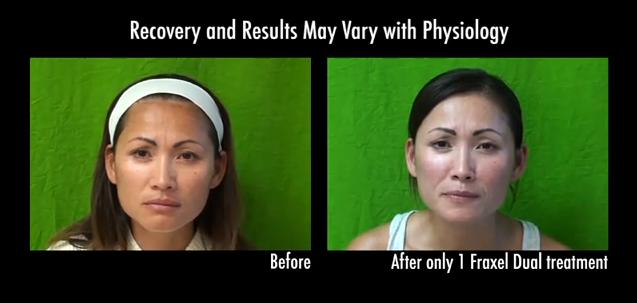Laser resurfacing can change skin tissue to improve cosmetic issues such as:
- Fine lines and wrinkles
- Loose, sagging skin
- Age spots
- Uneven pigmentation and complexion
- Scars
Laser energy is very precise and non-invasive. The procedures are essentially bloodless without the use of surgical instruments.
Los Angeles Laser Resurfacing-Different Laser Types

Los Angeles patient who was able to improve her complexion through laser rejuvenation with Fraxel Dual*
Every laser system relies on a single wavelength to perform very specialized functions. This is different from other types of light based cosmetic tools which use many different wavelengths. Doctors can set specific laser resurfacing parameters that:
1) control the amount of energy administered in a treatment
2) control the depth of penetration of the laser beam.
Fraxel Repair
Fraxel Repair is a carbon dioxide laser that uses a wavelength of 10,600nm. Unlike older types of CO2 lasers, it can treat very specific areas on the face that require correction. The rest of the skin is left alone. Patients are able to benefit from excellent results with less downtime.
Fraxel Repair procedures are offered by many Los Angeles dermatology offices, including Fine Touch Dermatology. In a laser resurfacing treatment, the energy is administered as numerous microscopic vertical columns of light that reach into deeper layers below the surface. The tissue in each column is vaporized. Because cells are actually removed, this is considered an ablative procedure. There are two basic effects that occur:
1) The skin’s surface area shrinks
2) The heat from this process stimulates the dermis layer to produce new collagen fibers
Fraxel Repair can also target and clear unwanted pigmentation by breaking up melanin containing structures in the skin.
Fraxel Dual
Fraxel Dual has two wavelength modalities:
- 1550nm wavelength: for deeper forms of laser resurfacing
- 1927nm wavelength for lighter forms of laser resurfacing
Unlike Fraxel Repair, laser resurfacing with Fraxel Dual is non-ablative. It does not get rid of tissue. Instead the laser energy reaches the dermis layer beneath the surface. The energy converts to heat, causing the dermal layer to create new collagen that firms the skin.
Fraxel Dual can also break up cell structures below the surface that contain melanin. After this is done, the body’s lymphatic systems removes the remains. This process is used to get rid of age spots.
Spectra Laser
The Spectra laser is an Nd:YAG laser that uses the 1064nm wavelength. Laser resurfacing procedures are considered to be mildly ablative. The outer layer of the skin is exfoliated in a way that is comparable to a chemical peel. At the same time collagen remodeling processes are also activated as the laser applies heat to the dermis.
Los Angeles Laser Resurfacing-Frequently Asked Questions
1) What are some side effects that can occur after the procedure?
The skin will often look red or pink after a laser resurfacing treatment. There may be some swelling and crusting of the top layer. Brownish discoloration may also occur. During this time sun protection is very important for successful healing.
2) What limitations do lasers have in creating cosmetic changes?
While lasers can offer many types of benefits, they are not able to completely transform severe forms of aging such as jowls and other forms of loose skin. According to the ASDS (American Society of Dermatologic Surgery) lasers are not a substitute for face lifts.
3) When can I start wearing makeup again after my laser resurfacing procedure?
Ideally patients should wait about a week or two before applying makeup. But your dermatologist can provide more specific instructions.
4) Who is able to conduct a laser resurfacing session?
Highly skilled and experienced dermatologic surgeons can perform laser resurfacing.
Los Angeles Laser Resurfacing-Consultations
Los Angeles laser resurfacing consultations are offered at Fine Touch Dermatology at no cost. Types of improvements and recommended laser systems will be discussed.
